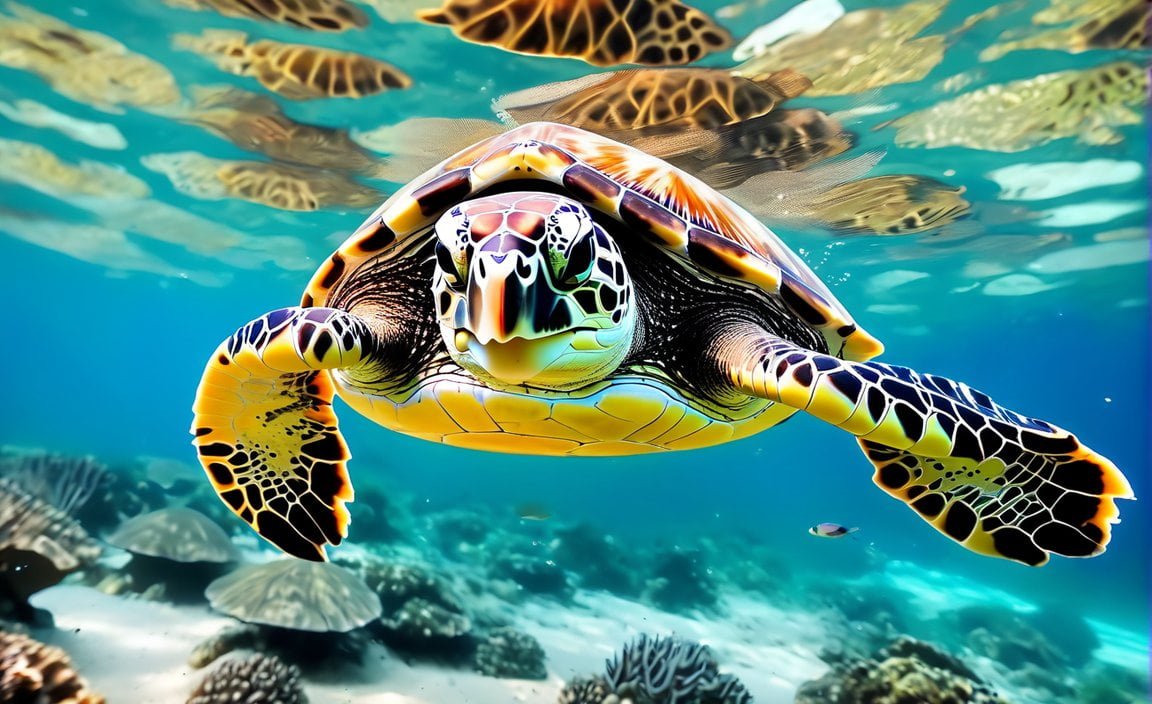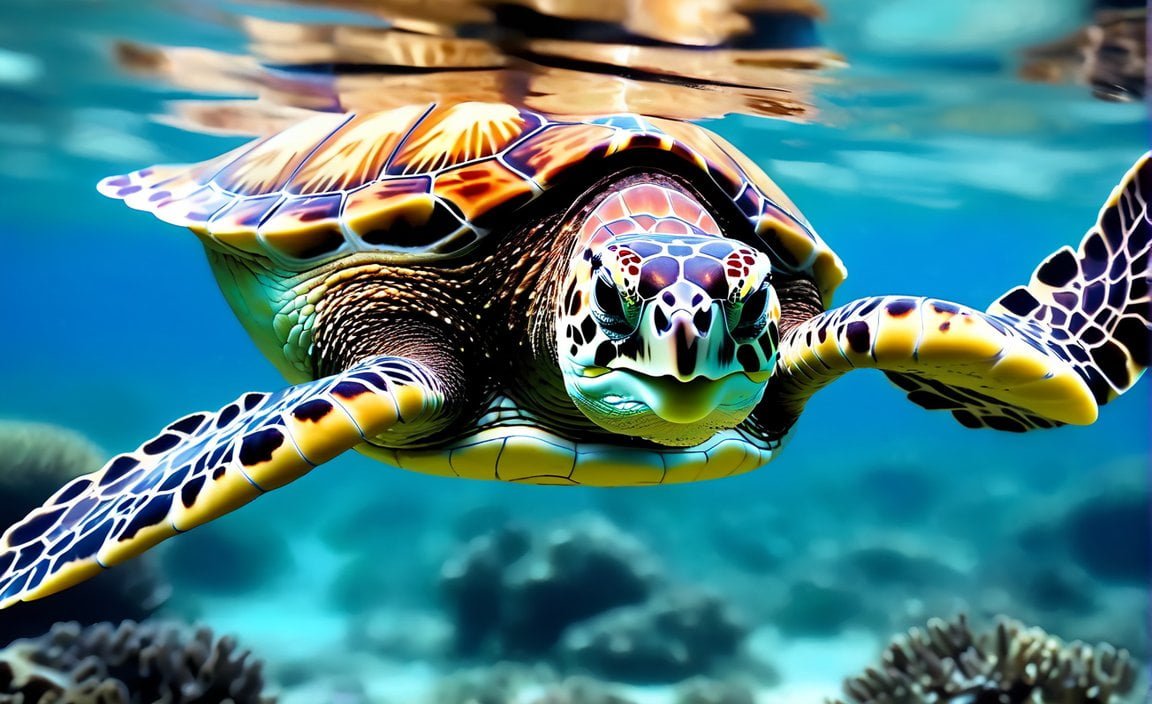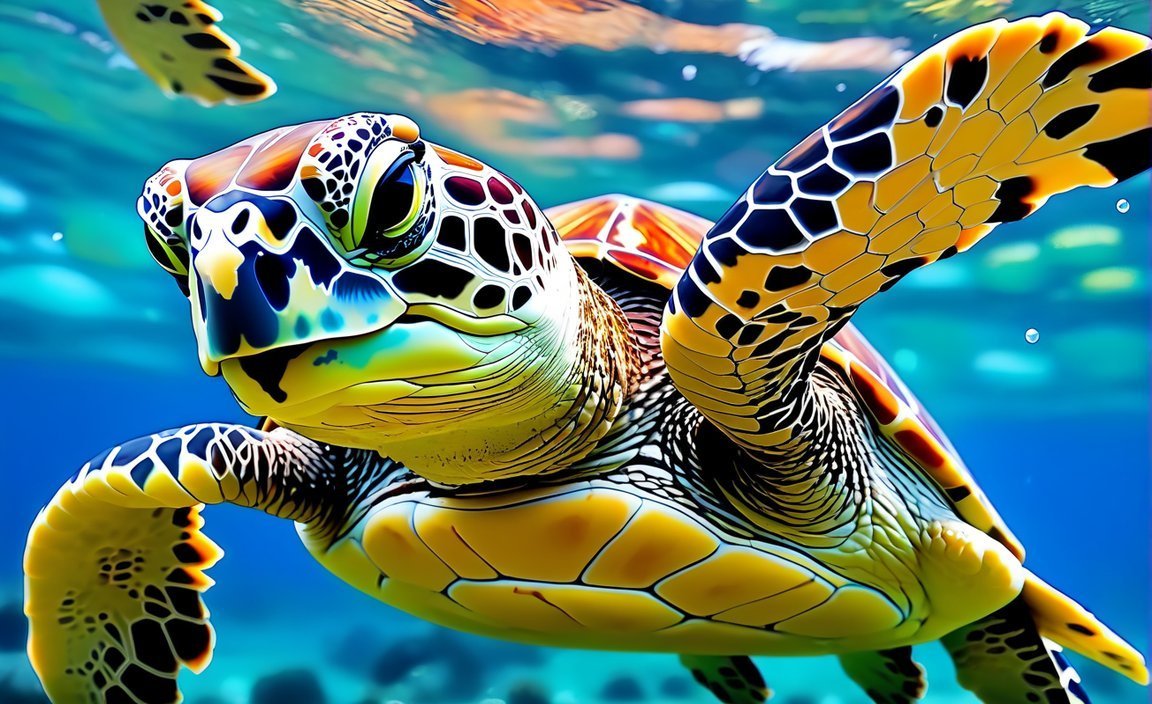Dive into the marvelous world of hawksbill sea turtles and discover 10 fascinating facts about these remarkable creatures. As marine conservationists and enthusiasts, it is crucial to understand the behavior, habitat, and conservation efforts surrounding hawksbill sea turtles. In this article, we will delve into their captivating world and shed light on their unique characteristics and significance in our marine ecosystem. Get ready to be amazed by the wonders of these majestic creatures as we uncover 10 intriguing facts about hawksbill sea turtles.

Key Takeaways:
- Hawksbill sea turtles are named for their long, narrow head and hawk-like beak.
- They have unique beak-like mouths and patterned shells.
- The largest colony of hawksbill sea turtles nests on Milman Island in Queensland, Australia.
- Hawksbill sea turtles have been swimming in the oceans for much longer than humans have been on Earth.
- They help keep coral reefs clean and thriving by eating sponges, making them the only species of sea turtle that can survive on a sponge-based diet.
- Hawksbill sea turtles play a vital role in the function of marine ecosystems.
- Conservation efforts are crucial for the protection of hawksbill sea turtles for future generations.
10 Interesting Facts About Hawksbill Sea Turtles
Hawksbill sea turtles are fascinating creatures that hold a special place in the marine ecosystem. Here are 10 interesting facts about hawksbill sea turtles that will captivate your imagination and deepen your appreciation for these majestic beings:
1. A Unique Appearance
Hawksbill sea turtles are instantly recognizable for their pointed beaks and stunning colors. Their long, narrow heads and distinctive beak-like mouths resemble that of hawks, giving them their name. Their shells are also adorned with intricate patterns, further adding to their allure[^1^][^2^].
2. Home to the Largest Colony
The Milman Island in Queensland, Australia is home to the largest known nesting colony of hawksbill sea turtles in the world. This breathtaking location serves as a vital sanctuary for these marvelous creatures[^1^].
3. Ancient Swimmers
Hawksbill sea turtles have been gracefully navigating the oceans for much longer than humans have existed on Earth. Their enduring presence is a testament to their ability to adapt and thrive in their watery homes[^1^].
4. Guardians of Coral Reefs
These incredible turtles play a crucial role in the health of coral reefs. Hawksbills keep the reefs clean and thriving by feasting on sponges. They are the only sea turtle species that can survive on a diet mainly composed of sponges[^2^][^3^].
5. Ecosystem Engineers
Hawksbill sea turtles are not just beautiful creatures, they are essential for the proper functioning of marine ecosystems. Through their feeding habits and interactions with their surroundings, they contribute to the intricate balance of the ocean environment[^3^].
6. Conservation Imperative
The conservation of hawksbill sea turtles is of utmost importance to ensure the survival of these magnificent beings for future generations. Efforts to protect their habitats and reduce threats are crucial for their long-term survival[^3^].
For more information and additional intriguing facts about hawksbill sea turtles and their conservation, you can visit the following sources:
These sources provide further details and interesting insights into the captivating world of hawksbill sea turtles.
Now that you have delved into the marvelous world of hawksbill sea turtles, you can truly appreciate the magic they bring to our oceans. These ten fascinating facts offer a glimpse into the beauty, importance, and ongoing efforts to protect these remarkable creatures.
Here are some captivating internal links to encourage you to click and explore more about these fascinating topics:
10 fun facts about hawksbill sea turtles: Dive into the world of hawksbill sea turtles with these intriguing facts.
10 human foods dogs can eat: Discover the surprising human foods that are safe and enjoyable for your furry friend.
10 human foods that are good for dogs: Unveil the healthy and nutritious human foods that can contribute to your dog’s well-being.
10 interesting facts about alligator snapping turtles: Delve into the captivating world of alligator snapping turtles with these fascinating facts.
10 interesting facts about being a veterinarian: Explore the exciting and fulfilling profession of being a veterinarian with these intriguing facts.
10 interesting facts about falcons: Soar through the skies of knowledge and discover fascinating facts about these majestic birds of prey.
10 interesting facts about hawksbill turtles: Journey into the intriguing world of hawksbill turtles and uncover their unique characteristics.
10 interesting facts about snapping turtles: Dive into the depths of knowledge and uncover intriguing facts about snapping turtles.
10 interesting facts about the hawksbill sea turtle: Discover the wonders of the hawksbill sea turtle and its importance to marine ecosystems with these fascinating facts.
Unique Physical Characteristics of Hawksbill Sea Turtles
Hawksbill sea turtles, with their distinctive appearance and fascinating physical features, are a marvel to behold. Let’s take a closer look at the unique physical characteristics of hawksbill sea turtles that make them truly remarkable.
1. Beak-like Mouth and Pointed Head
One of the most striking features of hawksbill sea turtles is their beak-like mouth, which gives them a distinctive appearance. Their lower jaw is V-shaped, while their head tapers to a point, resembling the beak of a hawk. This unique facial structure sets them apart from other sea turtle species, making them instantly recognizable.
2. Intricately Patterned Shell
The outer layer of a hawksbill sea turtle’s shell, known as the carapace, showcases a captivating and intricate pattern. The shells of hawksbill sea turtles are mottled with a beautiful combination of shades of amber, orange, red, yellow, black, and brown. Serrated edges and overlapping scutes further add to the shell’s stunning appearance.
3. Oval-shaped Body and Thick Scutes
Hawksbill sea turtles have a distinct oval-shaped body, which sets them apart from other turtle species. Their shells are jagged and composed of thick, bony plates called scutes. These scutes not only provide protection but also contribute to the unique appearance of hawksbill sea turtles.
4. Claws on Flippers
A noteworthy physical characteristic of hawksbill sea turtles is the presence of two visible claws on each flipper of their forelimbs. These claws serve various functions, including assisting the turtles in climbing on rocky surfaces and providing stability during nesting.
5. Size and Weight
While hawksbill sea turtles are relatively small to medium-sized compared to other sea turtle species, they still impress with their size. These majestic creatures can grow up to around 45 inches in shell length and weigh up to 150 pounds. It’s incredible to think about the strength and grace they possess despite their moderate size.
6. Heart-shaped Carapace
When young, hawksbill sea turtles boast an adorable heart-shaped carapace. As they mature, this shape elongates, evolving into the characteristic oval shape we typically associate with these turtles. Witnessing this transformation is a testament to the wonders of nature and the growth these creatures undergo throughout their lives.
7. Preferred Habitat and Feeding Habits
Hawksbill sea turtles primarily inhabit tropical oceans, with a particular preference for coral reefs. Their unique physical characteristics, such as their pointed beak and sharp mouth, are tailored perfectly for their feeding habits. Hawksbill sea turtles feed almost exclusively on sponges, using their specialized mouth to reach into cracks and crevices, contributing to the health and balance of coral reef ecosystems.
8. Endangered Status and Conservation Efforts
Unfortunately, despite their captivating physical characteristics, hawksbill sea turtles face significant threats and are classified as the most endangered sea turtle population worldwide. Habitat reduction and illegal hunting pose severe risks to their survival. Conservation efforts must prioritize habitat preservation and the prevention of illegal animal trading to protect these majestic creatures and ensure their existence for generations to come.
Key Takeaways:
- Hawksbill sea turtles possess a beak-like mouth, pointed head, and claws on their flippers, giving them a distinctive appearance.
- The intricate and captivating pattern on their shells adds to their unique physical characteristics.
- Hawksbill sea turtles have an oval-shaped body with thick scutes, providing both protection and visual appeal.
- They exhibit a heart-shaped carapace when young, which elongates as they mature.
- These turtles can grow up to approximately 45 inches in shell length and weigh up to 150 pounds.
- Hawksbill sea turtles are predominantly found in tropical oceans, particularly in coral reef habitats.
- With their specialized feeding habits, hawksbill sea turtles play an essential role in maintaining the health and balance of coral reef ecosystems.
- Hawksbill sea turtles face significant threats and are considered the most endangered sea turtle population worldwide.
- Conservation efforts should focus on habitat preservation and the prevention of illegal animal trading to ensure the survival of these magnificent creatures.
Sources:
1. American Oceans
2. National Geographic
Feeding Habits and Diet of Hawksbill Sea Turtles
Hawksbill sea turtles are truly remarkable creatures, with fascinating feeding habits and a diverse diet. Let’s dive into the marvelous world of these beautiful turtles and explore their unique feeding behaviors and preferred menu.
The Hawksbill’s Distinctive Features
Before we delve into their feeding habits, it’s important to mention some distinctive features of hawksbill sea turtles. With their beak-like mouth and pointed head, they possess a captivating appearance that sets them apart from other sea turtle species. Their shells, adorned with striking patterns in shades of amber, orange, red, yellow, black, and brown, are a sight to behold. These magnificent beings have an oval-shaped body with thick scutes on their shells and two visible claws on each flipper of their forelimbs.
The Omnivorous Diet of Hawksbill Sea Turtles
Hawksbill sea turtles take pride in their varied diet, which classifies them as omnivores. Seagrasses, sea urchins, barnacles, and small animals all form part of their meal plan. But their absolute favorite food? Sponges! Hawksbill sea turtles use their unique beak-like mouth to feast on these marine organisms, making them experts at finding food sources hidden in hard-to-reach cracks and crevices. Imagine a hawk skillfully maneuvering through challenging terrain to find its prey – that’s precisely how hawksbill sea turtles hunt for sponges!
This feeding habit plays a vital role in the health of coral reef ecosystems. By removing sponges from the reefs, hawksbill sea turtles facilitate better feeding access for reef fish. These interactions contribute to the overall balance and functioning of marine ecosystems, which depend on healthy coral reefs.
Conservation of Hawksbill Sea Turtles
The importance of these graceful creatures in the marine world cannot be overstated. Unfortunately, hawksbill sea turtles are the most endangered sea turtle population globally, primarily due to habitat loss, pollution, coastal development, and the illegal trade of their beautiful shells.
To protect hawksbill sea turtles and ensure their survival for generations to come, conservation efforts should focus on habitat preservation and the prevention of illegal animal trading. By raising awareness and taking action, we can safeguard the future of these fascinating creatures and the invaluable roles they play in maintaining the health of coral reefs and marine ecosystems.
Key Takeaways:
– Hawksbill sea turtles have a varied diet, consuming seagrasses, sea urchins, barnacles, small animals, and their favorite food, sponges.
– Their unique beak-like mouth enables them to find food sources in hard-to-reach cracks and crevices.
– By feeding on sponges, hawksbill sea turtles contribute to better feeding access for reef fish, maintaining the balance of coral reef ecosystems.
– Hawksbill sea turtles face numerous threats, including habitat loss, pollution, coastal development, and the illegal trade of their shells.
– Conservation efforts should prioritize habitat preservation and the prevention of illegal animal trading to protect these critically endangered sea turtles.
Sources:
– National Wildlife Federation – Hawksbill Sea Turtle
– NOAA Fisheries – Hawksbill Turtle
Conservation Efforts and Challenges for Hawksbill Sea Turtles
Sea turtles are fascinating creatures that captivate our imagination with their unique appearance and vital role in maintaining the health of marine ecosystems. Among the various sea turtle species, hawksbill sea turtles stand out with their beak-like mouths, pointed heads, and captivating patterned shells. However, these magnificent creatures face numerous conservation challenges that threaten their survival.
1. The Plight of the Hawksbill Sea Turtles
The hawksbill sea turtle (Eretmochelys imbricata) is classified as Critically Endangered on the IUCN Red List, with a population decline of over 80% in the last century. The Eastern Pacific population of hawksbill turtles is one of the most threatened. The main contributors to their decline are human hunting and the harvesting of their eggs. Shockingly, between 1970 and 1986, Indonesia alone exported over 700,000 specimens of tortoiseshell and stuffed curios, contributing to the decline of hawksbill turtles.
2. The Magnificence of Hawksbill Sea Turtles
Hawksbill sea turtles are known for their unique physical traits. They have an oval-shaped body, thick scutes on their shells, and two visible claws on each flipper of their forelimbs. These turtles can grow up to 45 inches in shell length and weigh up to 150 pounds. Young hawksbill sea turtles have a distinct heart-shaped carapace that elongates as they mature. Their pointed beaks and stunningly patterned shells, featuring shades of amber, orange, red, yellow, black, and brown, make them a sight to behold.
3. The Habitat and Feeding Habits of Hawksbill Sea Turtles
Hawksbill sea turtles primarily inhabit tropical oceans, especially coral reef habitats. They play a crucial role in the health of coral reefs by feasting on sponges and keeping the reefs clean and thriving. Their beak-like mouths allow them to access food in hard-to-reach cracks and crevices, particularly sponges. By feeding on sponges, they facilitate better feeding access for reef fish, contributing to the balance of coral reef ecosystems.
4. Conservation Efforts for Hawksbill Sea Turtles
Conservation efforts are of utmost importance to protect hawksbill sea turtles and ensure their survival for future generations. The conservation status of hawksbill turtles is assessed using factors such as isolation, designated spatial protection status, presence of local engagement, and fishing pressure. Satellite tracking has been utilized to improve conservation outcomes for nesting hawksbill turtles by providing valuable insights. For example, a study conducted by The Nature Conservancy tracked 30 hawksbill sea turtles from the Solomon Islands, which offered significant contributions to conservation efforts.
5. Challenges in Protecting Hawksbill Sea Turtles
Protecting hawksbill sea turtles requires addressing various challenges. Habitat preservation is a critical aspect of conservation efforts, as habitat loss due to coastal development and pollution poses a significant threat. Additionally, illegal animal trading, particularly the illegal shell trade, further endangers these critically endangered turtles. Overcoming these challenges necessitates a collective effort from individuals, organizations, and governments to enforce regulations, increase awareness, and support conservation initiatives.
Key Takeaways:
- Hawksbill sea turtles are critically endangered, facing significant population decline due to human hunting and egg harvesting.
- Their unique physical traits include beak-like mouths, pointed heads, and stunningly patterned shells.
- Hawksbill sea turtles play a vital role in maintaining the health of coral reef ecosystems by feeding on sponges.
- Conservation efforts focus on factors such as nesting site protection, satellite tracking, and habitat preservation.
- Challenges in protecting hawksbill sea turtles include habitat loss, coastal development, pollution, and illegal shell trade.
Sources:
– Cambridge University Press & Assessment
– World Wildlife Fund

FAQ
Q1: How do hawksbill sea turtles get their name?
A1: Hawksbill sea turtles are named for their long, narrow head and their hawk-like beak.
Q2: Where can I find hawksbill sea turtles?
A2: Hawksbill sea turtles are found in tropical oceans, predominantly in coral reefs.
Q3: What is the diet of hawksbill sea turtles?
A3: Hawksbill sea turtles feed mainly on sponges, using their sharp, beak-like mouth to reach into cracks and crevices. They also consume seagrasses, sea urchins, barnacles, and other small animals.
Q4: How many times do hawksbill sea turtles nest in a season?
A4: Hawksbill sea turtles nest nearly four times per season, with each nest containing approximately 140 eggs.
Q5: Why are hawksbill sea turtles endangered?
A5: Hawksbill sea turtles are critically endangered due to habitat reduction, illegal hunting, and the illegal trade of their shells, known as tortoiseshell.










